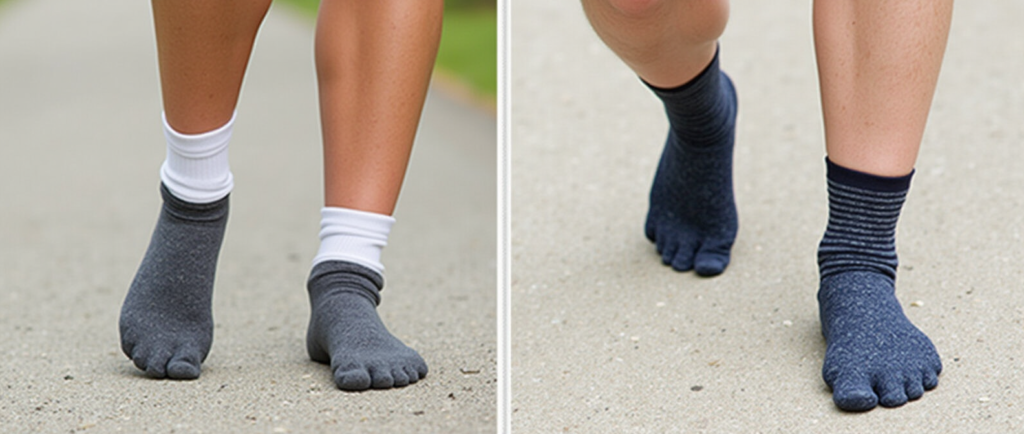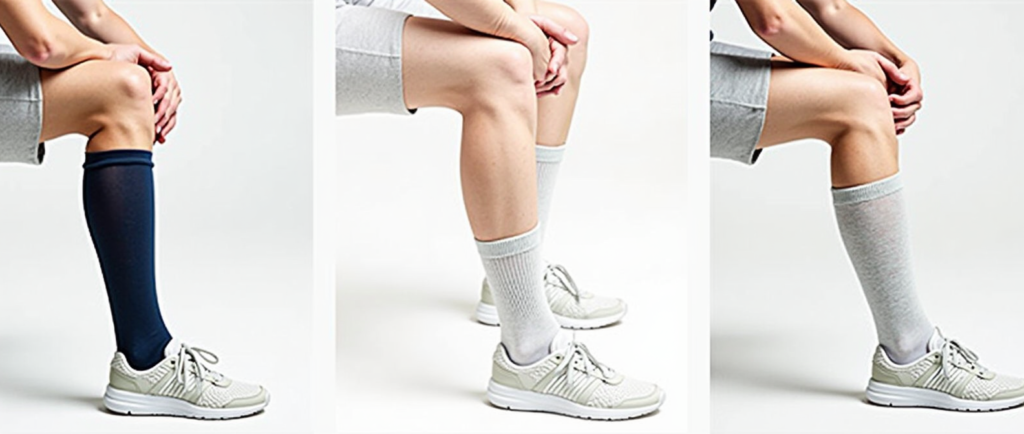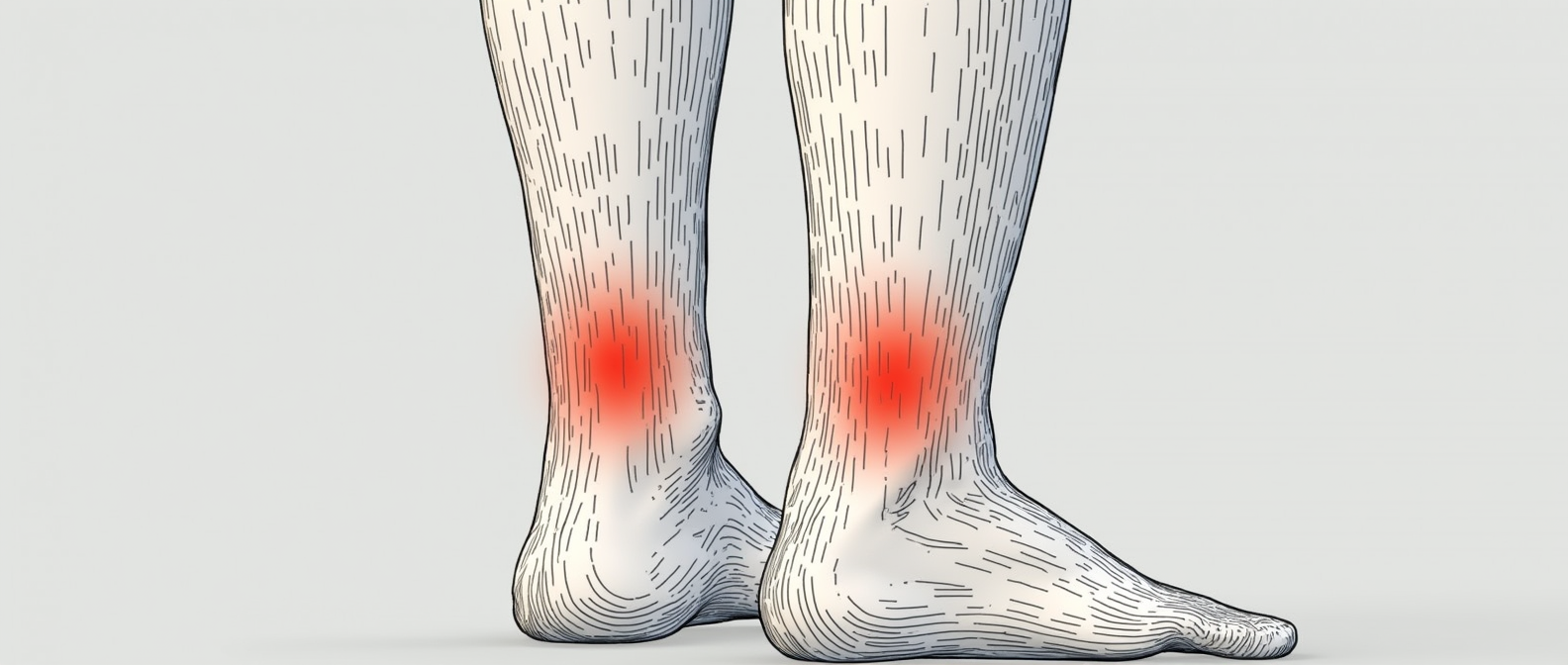Running and high-impact sports are getting more popular. Athletes and fitness fans are looking for ways to avoid and treat injuries like shin splints. Compression socks have become a popular choice for relief and support.
But do they really help with shin splints? Let’s look at the facts and see if compression socks are worth it for this common lower-leg issue.
Table of Contents

Understanding Shin Splints and Their Impact on Athletes
Shin splints, also known as medial tibial stress syndrome, are a common injury for runners. They happen when the muscles, tendons, and bone around the shinbone get inflamed. This leads to pain and discomfort.
What Causes Medial Tibial Stress Syndrome
Medial tibial stress syndrome is often caused by overuse or bad training techniques. It can also happen when there’s too much stress on the lower legs. Things that might lead to shin splints include:
- Sudden increase in running mileage or intensity
- Wearing improper or worn-out running shoes
- Running on hard or uneven surfaces
- Muscle imbalances or weaknesses in the lower extremities
Common Symptoms and Risk Factors
The main symptom of medial tibial stress syndrome is a dull, achy pain along the front of the lower leg. This pain gets worse with physical activity and can get even worse if not treated. Things that might make an athlete more likely to get shin splints include:
- High-impact sports, such as running, basketball, or soccer
- Flat feet or overpronation
- Poor running form or technique
- Sudden increases in training volume or intensity
Impact on Athletic Performance
Shin splints can really hurt an athlete’s performance. The pain and discomfort make it hard to train and compete well. In bad cases, shin splints can cause athletes to miss training or competitions. This can set back their progress and performance.
It’s important to treat and prevent medial tibial stress syndrome. This is key for athletes and runners who want to improve their performance and avoid long-term problems.
Do Compression Socks Help With Shin Splints: Evidence-Based Research
Compression socks are popular among athletes for treating shin splints. But do they really work? Let’s look at the science to see if they help with shin splint treatment.
Many studies have looked into how compression socks affect shin splint symptoms. A 2020 study in the Journal of Sports Science and Medicine found that runners with shin splints felt less pain and performed better when wearing compression socks.
Another study in the International Journal of Sports Physical Therapy found that compression socks improved blood flow and reduced muscle fatigue. This could help in recovering from shin splints.
| Study | Findings |
|---|---|
| Journal of Sports Science and Medicine (2020) | Runners who wore compression socks experienced reduced pain and improved performance during and after running. |
| International Journal of Sports Physical Therapy | Compression socks enhanced blood circulation and reduced muscle fatigue, potentially aiding in the recovery process for shin splints. |
While the research looks good, results can vary. The severity of shin splints, the type of socks, and how long they’re worn all matter. Always talk to a doctor or sports medicine expert to find the best treatment for shin splints.

How Compression Technology Works for Leg Pain Relief
Compression socks and sleeves are popular for athletes and those with leg pain, like shin splints. The technology behind these garments is key to their benefits. Let’s look at how compression technology helps with leg pain.
Graduated Compression Explained
The design of compression socks and sleeves is what makes them work. They have the most pressure at the ankles or calves. This pressure decreases as you go up the leg. This design boosts blood flow, helping muscles get more oxygen and recover better.
Blood Flow and Muscle Support Benefits
Compression socks and sleeves apply pressure to improve blood flow. This reduces blood pooling in the legs. It also helps remove waste that causes muscle fatigue and pain. Plus, they offer muscle support, easing the strain on leg muscles during exercise.
Pressure Levels and Their Effects
Compression garments have different pressure levels, measured in mmHg. For shin splints, 15-20 mmHg is best. This pressure level boosts blood flow without being too tight, offering the right balance of support and comfort.
Understanding compression technology shows how calf compression sleeves and compression socks help with leg pain relief for shin splints. Their graduated compression, improved blood flow, and muscle support together ease symptoms and aid in recovery.
Choosing the Right Compression Socks for Shin Splint Treatment
When you have shin splints, the right compression socks can really help. They can improve your recovery and how well you perform in sports. It’s important to pick the right ones for the best support and relief.
First, find compression socks with the right amount of pressure. Shin splints usually need moderate to high pressure, about 20-30 mmHg. This pressure helps blood flow better, reduces swelling, and supports your muscles.
The material of the socks is also key. Choose ones made from breathable, moisture-wicking fabrics like nylon or polyester. These keep your feet and legs cool and dry, preventing irritation or chafing while you exercise.
Finding the right fit is crucial. Measure your calf and foot to get the right size. If the socks are too tight, they can cut off circulation. If they’re too loose, they won’t support your muscles well.
| Compression Level | Recommended for Shin Splints | Potential Benefits |
|---|---|---|
| Moderate (20-30 mmHg) | Yes | Improved blood flow, reduced swelling, muscle support |
| High (30-40 mmHg) | Yes | Enhanced circulation, increased muscle recovery, enhanced athletic performance |
| Graduated (higher at ankles, lower at calves) | Yes | Improved venous return, reduced risk of pooling |
If you’re an athlete or runner with shin splints, look for sports-specific compression socks. These socks have extra features like reinforced heels and toes, arch support, and are made to last through tough training and competitions.
By carefully choosing the right compression socks for your shin splints, you can get the most out of them. They’ll help your body recover, perform better, and prevent future injuries.

Best Practices for Using Compression Socks During Exercise
Compression socks are popular among athletes for running injury prevention and exercise recovery aids. They offer targeted support. But, to get the most out of them, it’s key to use them correctly.
Proper Fitting Guidelines
It’s important to wear compression socks that fit snugly but comfortably. They should cover your lower leg, from your foot arch to just below your knee. To find the right size, measure your calf and ankle. This ensures the socks fit your body well.
When to Wear Them
- Before exercise: Wearing them during your warm-up boosts blood flow and gets your muscles ready.
- During exercise: They offer ongoing support and help prevent muscle fatigue and soreness.
- After exercise: They help with recovery by improving circulation and reducing swelling.
Maintenance and Care Tips
- Wash them after each use to keep them effective and prevent odors.
- Don’t use fabric softener or bleach, as they can damage the fibers.
- Keep them in a cool, dry place to avoid stretching or damage.
- Replace them every 6-12 months or as the manufacturer suggests for best performance.
By following these tips, you can get the most out of your compression socks. They’ll help with running injury prevention, exercise recovery aids, and lower leg support gear.
Combining Compression Therapy with Other Recovery Methods
Treating shin splints often requires a mix of methods. Compression socks help support and aid in healing. But using them with other recovery methods can make treatment even better.
Stretching and strengthening exercises are key to compression therapy. They target the muscles and tissues in the lower leg. This helps fix the root causes of shin splints and boosts flexibility and stability. Icing the area can also help reduce inflammation and pain, working well with the socks’ compression.
Compression socks might also help those with neuropathy. This condition causes nerve damage and pain in the legs and feet. The socks’ compression can improve blood flow and muscle support, possibly easing neuropathy symptoms.
Using a variety of exercise recovery aids can lead to a well-rounded treatment plan. This approach tackles the complex nature of shin splints and related leg issues. It can speed up healing, enhance performance, and lower the chance of future injuries.
Conclusion
Compression socks can help with shin splints, or medial tibial stress syndrome. They apply graduated compression to improve blood flow and support muscles. This reduces the impact of activity on the lower legs.
This can ease the pain and discomfort of shin splints. It lets athletes and active people recover faster and get back to their activities sooner.
While research shows compression socks can be helpful, results vary. The condition’s severity, the socks’ quality and fit, and the rehabilitation approach matter. Always talk to a healthcare professional before using compression socks or any treatment.
Compression socks are a valuable treatment for shin splints. They offer a safe, non-invasive way to manage symptoms and speed up healing. By understanding how they work and using them correctly, people with shin splints can manage their condition and stay active.
FAQ
Do compression socks really help with shin splints?
Yes, studies show that compression socks can help with shin splints. They improve blood flow and reduce muscle vibration. This can help with pain and speed up recovery.
How do compression socks work to treat shin splints?
Compression socks apply pressure that gets stronger as you go up the leg. This pressure boosts blood flow and supports the lower leg. It helps with healing and reduces swelling.
What are the benefits of using compression socks for shin splint treatment?
Using compression socks for shin splints has many benefits. They reduce pain and improve blood flow. They also help with muscle vibration and support injured tissues. This can lead to faster recovery and prevent future problems.
How should compression socks be used for shin splint treatment?
To use compression socks for shin splints, follow these tips. Choose a compression level between 15-30 mmHg for support and comfort. Wear them during exercise and rest. Make sure they fit well and take care of them to keep them effective.
Can compression socks help with other leg-related issues besides shin splints?
Yes, compression socks can help with many leg issues. They can ease neuropathy, swelling, muscle cramps, and general discomfort. They are useful for a wide range of leg problems, especially those related to blood flow and muscles.

